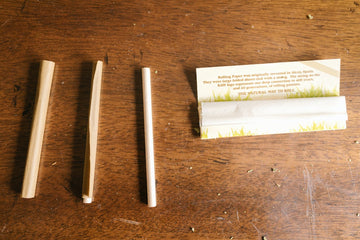News
History of the Rolling Paper Industry
Modern rolling papers are works of art, but it's taken centuries of trial and error to produce high-quality papers like Empire Rolling's $100 Bill Premium Rolling Papers. Plus, while rolling papers are primarily associated with head shops and marijuana smoking these days, these smoking implements weren't always staples of the cannabis counterculture. Learn more about the history of the rolling paper industry and how rudimentary newspaper scraps gradually evolved into the perfected papers we know and love today.

Ancient Origins
People have been smoking stuff for a long time. Lighting plants on fire and inhaling the smoke has existed for millennia, and no one knows who took the first puff. However, we understand that a pictograph from South America made sometime around 600 AD shows a Mayan man smoking a roll of tobacco strings tied together with a leaf. So the history of marijuana smoking in India goes back even further.
However, people didn't usually smoke marijuana, tobacco, or other popular smoking plants with rolling papers back in the day. Instead, they used pipes or plant leaves. To this day, cigars are rolled with dried tobacco leaves, and it's still just as common to see people using glass pipes, water pipes, or bongs as it is to see someone rolling a blunt.
Rolling Papers in the Old World
As tobacco became more and more of a precious commodity in Europe, people started coming up with unique ways to conserve and smoke this novel substance. While people in the Americas had been smoking tobacco since around 6000 BC, Europeans had never had a single puff of this addictive substance until the colonization of North and South America began in the mid-1400s.
Tobacco quickly became a luxury item that the elite flaunted in front of their peasant subjects. As they gallivanted around in their carriages smoking cigars rolled in tobacco or palm leaves, they would toss the butts onto the side of the road. These butts would be clamored over and claimed by poor people almost immediately, and their contents would be removed and smoked again.
Without having access to dried tobacco leaves or similar rolling materials, peasants in Spain and other parts of Europe had a hard time using this leftover tobacco until someone had the bright idea to roll the discarded tobacco in scraps of newspaper. In desperation, these peasants neither knew nor cared that these newspaper scraps contained dangerous chemicals like lead and cadmium. Instead, they puffed away and marveled at their luck and ingenuity.
The Dawn of an Industry
Over time, papermakers in Europe became thoroughly disgusted that poor and working people were using scraps of filthy paper to smoke tobacco. However, this disgust alone wouldn't have motivated the inception of the rolling paper industry if it weren't for another factor: greed. Papermakers sensed that they could make money by producing rolling papers, so various paper factories in Spain started churning out these tiny rectangular pieces of paper en masse.
For several decades, the phenomenon of rolling papers remained limited to Spain. In 1532, however, a Frenchman named Alexandro Rizlette de Crampton Lacroix traded a bottle of champagne for a packet of rolling papers. This technology passed to France and the rest of Europe.
While Alexandro would perish before his family name became associated with rolling papers across the continent, his descendants carried the torch forward and founded the Lacroix Rolling Paper company in 1736. Near the beginning of the 19th century, Lacroix Rolling Paper received its first big contract from Napoleon, fresh from rising to dominance after the French Revolution.
Napoleon had noted that his soldiers were using pages from books to roll cigarettes. While it's unknown whether he was acting out of his love of literature or his passion for his soldiers, he decided to supply his entire army with clean-burning, high-quality rolling papers. Ever-increasing success rapidly made Lacroix Rolling Paper the biggest producer of rolling papers on the continent. In 1865, this company changed its name to Rizla after deciding to incorporate rice fiber into its formula.

Rolling Papers in the Modern World
While various fibers are still used to make rolling papers, Rizla's switch to rice cemented this fiber's dominance as the world's rolling paper material of choice. However, throughout the 19th and 20th centuries, flax, wood pulp, flax, and hemp remained common in rolling papers, and some of these materials are still used to this day.
Whenever anyone in the Western world wanted to roll up a cigarette between 1850 and 1950, they reached for a Rizla paper. The Lacroix family continued to increase its fame and fortune on both sides of the Atlantic Ocean, and in 1942, they invented the gum strip at the edge of rolling papers that remains a staple of the industry to this day.
As the 20th century progressed, the idea of rolling papers caught on in a big way. The emergence of cigarettes partially spurred on this popularity as the vice of choice of many trendy Westerners. However, factory-rolled cigarettes, also known as "tailor-made" smokes, were expensive and hard to come by in some rural areas, which incentivized many people to roll up their cigarettes with papers by Rizla, Job, and Zig-Zag.
In places like prisons where pre-rolled cigarettes were rare but loose tobacco was abundant, rolling paper brands like Bugler thrived. In the latter decades of the 20th century, another factor pushed the rolling paper industry to new heights.
With the hippie movement came the increased popularity of marijuana. While plenty of hippies used bongs, water pipes, and other glass pipes to smoke dope, the rolling paper was the preferred tool for getting high for many free-loving hippies of the 1960s and 1970s. By the 1980s, smoking marijuana was relatively mainstream. As many states have legalized marijuana for medical or recreational use, rolling papers have become even more of a mainstay of youth and music culture in the United States and beyond.
Marijuana users, known for their crafty combination of laziness and creativity, have come up with tons of ways to use rolling papers to make joints. From cone joints to cross joints to rose blunts, the meeting of marijuana and rolling papers has yielded several inventive rolling techniques.

Today's Rolling Papers
Today, companies like Empire Rolling have led the charge in making rolling papers fun, unique, and inexpensive. So whether you're looking for flavor papers or the materials to create a cone joint, it's easy to find tons of different types of rolling papers to suit your needs, and you can even find joint filters to make smoking healthier if you look hard enough.
Inventions like manual and automatic rolling machines have made it easier than ever to make professional-quality rollies in the comfort of your own home. In addition, it's now possible to find rolling papers free from the dyes and other additives that have made smoking needlessly dangerous for hundreds of years.
There doesn't appear to be any clear end to the ongoing story of rolling papers. As long as there are entrepreneurs who want to make rolling a blunt or joint easier, rolling papers will continue to get better and better. Throughout it all, Empire Rolling will be there, pioneering the way forward in the incredible history of rolling papers.






















